Learn how to install Zabbix on Rocky Linux 9 with our detailed step-by-step guide. Set up this powerful monitoring solution to keep track of your network, servers, and applications efficiently. #centlinux #linux #zabbix
Table of Contents
What is Zabbix?
Zabbix is an open-source software tool to monitor IT infrastructure such as networks, servers, virtual machines, and cloud services. Zabbix collects and displays basic metrics.
Zabbix is designed primarily as an IT infrastructure monitoring tool. New features are generally released every six months to major versions and every 1.5 years to LTS versions.
Released under the terms of GNU General Public License version 2, Zabbix is free software that does not require a license to use any of its features. Even though Zabbix is open-source software, it is a closed development software product, developed by Zabbix LLC based in Riga, Latvia.
Early in its history, Zabbix was described as simple to set up compared to other monitoring solutions. However, later it was considered by some to need a significant amount of manual configuration. As an open-source product however Zabbix focuses on the usage of existing tools and functionality as well as proprietary solutions to achieve a scalable monitoring solution. (Source: Wikipedia)
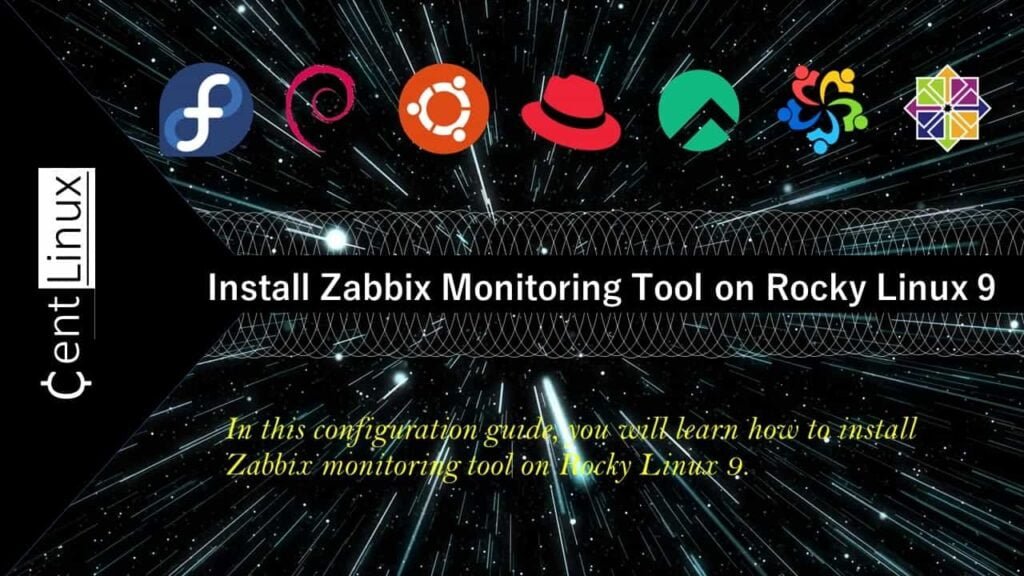
Zabbix Alternatives
Several alternatives to Zabbix offer robust monitoring solutions for network, server, and application management. Here are some popular Zabbix alternatives:
- Pros: Highly customizable, extensive plugin library, strong community support.
- Cons: Steeper learning curve, configuration can be complex.
- Pros: Excellent for time-series data, powerful querying language (PromQL), integrates well with Kubernetes.
- Cons: Requires additional tools for full-stack monitoring, steeper learning curve for complex queries.
SolarWinds Network Performance Monitor (NPM)
- Pros: Comprehensive network monitoring, user-friendly interface, detailed reporting.
- Cons: Commercial product with associated costs, may be overkill for smaller networks.
PRTG Network Monitor
- Pros: Easy to set up and use, all-in-one solution, includes alerts and reporting.
- Cons: Commercial product, limited free version.
- Pros: Flexible configuration, good for large environments, strong community and documentation.
- Cons: Initial setup can be complex, requires configuration management.
Grafana with Prometheus
- Pros: Powerful visualization, excellent for monitoring time-series data, highly customizable.
- Cons: Requires separate setup and configuration, Prometheus knowledge needed.
- Pros: Auto-discovery of hosts and services, scalable, strong community version.
- Cons: Some features locked behind enterprise version, initial setup can be complex.
Datadog
- Pros: Cloud-native, integrates with numerous services and applications, strong visualization and alerting.
- Cons: Commercial product, can become costly with scale.
Sensu
- Pros: Scalable, supports monitoring as code, strong integration capabilities.
- Cons: Requires configuration and setup, commercial version for advanced features.
Opsview
- Pros: Scalable, comprehensive features for enterprise environments, good integration with various technologies.
- Cons: Commercial product, can be costly for smaller setups.
Each of these alternatives has its own strengths and weaknesses, and the best choice depends on your specific requirements, such as the size of your environment, budget, and specific monitoring needs.
Read Also: How to install Zabbix on Rocky Linux 10
Environment Specification
We are using a minimal Rocky Linux 9 virtual machine with following specifications.
- CPU – 3.4 Ghz (2 cores)
- Memory – 2 GB
- Storage – 20 GB
- Operating System – Rocky Linux release 9.0 (Blue Onyx)
- Hostname – zabbix-01.centlinux.com
- IP Address – 192.168.116.131/24
For those setting up Zabbix on Rocky Linux 9, a reliable and efficient environment is key. Whether you prefer a compact physical setup or a scalable cloud solution, consider using a Mini PC or a VPS from Rose Hosting to build your Home Lab. A Mini PC offers dedicated local hardware for hands-on Linux server experimentation, ideal for learning and testing in a controlled environment.
[Limited Time Mini PC Offers – Click and Save!]
Alternatively, Rose Hosting’s VPS provides flexible remote access with robust resources, perfect for running Zabbix monitoring without hardware constraints.
[Launch Your Own VPS with Rose Hosting – Click to Get Started!]
Both options support seamless experimentation and real-world server management practice, making them excellent choices for your Zabbix deployment journey.
Disclaimer: This post contains affiliate links. If you purchase through these links, I may earn a commission at no extra cost to you, helping support future tutorials and content.
Install Linux Software Updates
By using a ssh client, login to your Rocky Linux server as root user.
Set a FQDN (Fully Qualified Domain Name) for your network monitoring server by executing hostnamectl command.
hostnamectl set-hostname zabbix-01.centlinux.comRefresh your yum cache as follows.
dnf makecache --refreshExecute the following dnf command to install Linux software updates.
dnf update -yIf the above command installs software updates related to Linux Kernel, then you should reboot your operating system with latest Kernel.
rebootAfter successful reboot, check the versions of Linux operating system and Kernel.
cat /etc/rocky-release
uname -rOutput:
Rocky Linux release 9.0 (Blue Onyx)
5.14.0-70.22.1.el9_0.x86_64
Installing MariaDB Server
MariaDB 10.5 is available in standard yum repositories of Rocky Linux 9.0, which is supported by Zabbix 6.0.
Therefore, we are using MariaDB 10.5 in this server configuration guide. However, you can also install latest version of MariaDB Server.
dnf install -y mariadb-server mariadbEnable and start database Service.
systemctl enable --now mariadb.serviceInitialize database instance and set a password for super admin.
mariadb-secure-installationOutput:
NOTE: RUNNING ALL PARTS OF THIS SCRIPT IS RECOMMENDED FOR ALL MariaDB
SERVERS IN PRODUCTION USE! PLEASE READ EACH STEP CAREFULLY!
In order to log into MariaDB to secure it, we'll need the current
password for the root user. If you've just installed MariaDB, and
haven't set the root password yet, you should just press enter here.
Enter current password for root (enter for none):
OK, successfully used password, moving on...
Setting the root password or using the unix_socket ensures that nobody
can log into the MariaDB root user without the proper authorisation.
You already have your root account protected, so you can safely answer 'n'.
Switch to unix_socket authentication [Y/n] n
... skipping.
You already have your root account protected, so you can safely answer 'n'.
Change the root password? [Y/n] Y
New password:
Re-enter new password:
Password updated successfully!
Reloading privilege tables..
... Success!
By default, a MariaDB installation has an anonymous user, allowing anyone
to log into MariaDB without having to have a user account created for
them. This is intended only for testing, and to make the installation
go a bit smoother. You should remove them before moving into a
production environment.
Remove anonymous users? [Y/n] Y
... Success!
Normally, root should only be allowed to connect from 'localhost'. This
ensures that someone cannot guess at the root password from the network.
Disallow root login remotely? [Y/n] Y
... Success!
By default, MariaDB comes with a database named 'test' that anyone can
access. This is also intended only for testing, and should be removed
before moving into a production environment.
Remove test database and access to it? [Y/n] Y
- Dropping test database...
... Success!
- Removing privileges on test database...
... Success!
Reloading the privilege tables will ensure that all changes made so far
will take effect immediately.
Reload privilege tables now? [Y/n] Y
... Success!
Cleaning up...
All done! If you've completed all of the above steps, your MariaDB
installation should now be secure.
Thanks for using MariaDB!
Verify the database version as follows.
mysql -VOutput:
mysql Ver 15.1 Distrib 10.5.16-MariaDB, for Linux (x86_64) using EditLine wrapper
Install Zabbix on Rocky Linux 9
Zabbix official website provides the installation/configuration steps to install various available versions of Zabbix on your preferred platform.
You are only required to select your platform, Zabbix version, database and web server.

Although the version 6.2 of Zabbix is available, but we prefer to use a LTS (Long Term Support) version, therefore, we are installing Zabbix 6.0.
Use rpm command to install Zabbix 6.0 official yum repository.
rpm -Uvh https://repo.zabbix.com/zabbix/6.0/rhel/9/x86_64/zabbix-release-6.0-4.el9.noarch.rpmOutput:
Retrieving https://repo.zabbix.com/zabbix/6.0/rhel/9/x86_64/zabbix-release-6.0-4.el9.noarch.rpm
warning: /var/tmp/rpm-tmp.TnPIni: Header V4 RSA/SHA512 Signature, key ID 08efa7dd: NOKEY
Verifying... ################################# [100%]
Preparing... ################################# [100%]
Updating / installing...
1:zabbix-release-6.0-4.el9 ################################# [100%]
Build yum cache for newly installed yum repositories.
dnf makecacheInstall Zabbix server and relevant software packages by using dnf command.
dnf install -y zabbix-server-mysql zabbix-web-mysql zabbix-apache-conf zabbix-sql-scripts zabbix-selinux-policy zabbix-agentLogin to MariaDB by using mysql command and create a database to use as Zabbix back-end data store.
mysql -u root -pExecute following commands at MySQL Prompt to create required database and user for Zabbix Server.
create database zabbix character set utf8mb4 collate utf8mb4_bin;
create user zabbix@localhost identified by '123';
grant all privileges on zabbix.* to zabbix@localhost;
quit;Zabbix software also shipped with a SQL script to create objects in it’s back-end data store.
You can use zcat command to unzip and forward the output to mysql command for immediate execution.
zcat /usr/share/zabbix-sql-scripts/mysql/server.sql.gz | mysql --default-character-set=utf8mb4 -uzabbix -p zabbixEdit Zabbix configuration file by using vim text editor.
vi /etc/zabbix/zabbix_server.confLocate and set the following directive in this file.
DBPassword=123Enable and start Zabbix server and agent along with Apache and PHP services.
systemctl enable --now zabbix-server zabbix-agent httpd php-fpmAllow the http service in Linux Firewall.
firewall-cmd --permanent --add-service=http
firewall-cmd --reloadInstall Zabbix Dashboard
Open URL http://zabbix-01.centlinux.com/zabbix in a web browser.
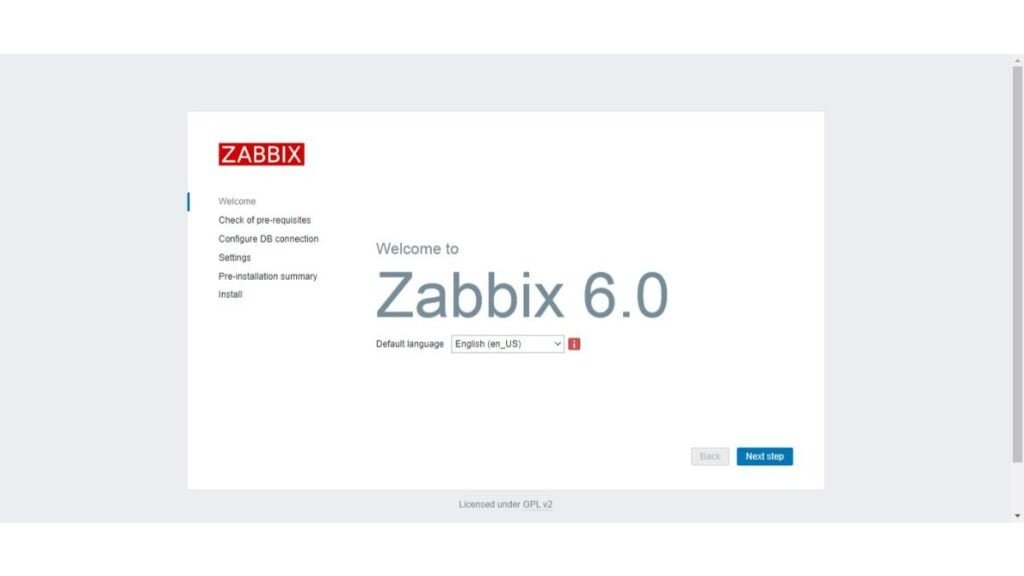
It will show you the Zabbix Dashboard welcome page.
Select the default language and click on “Next Step” button.
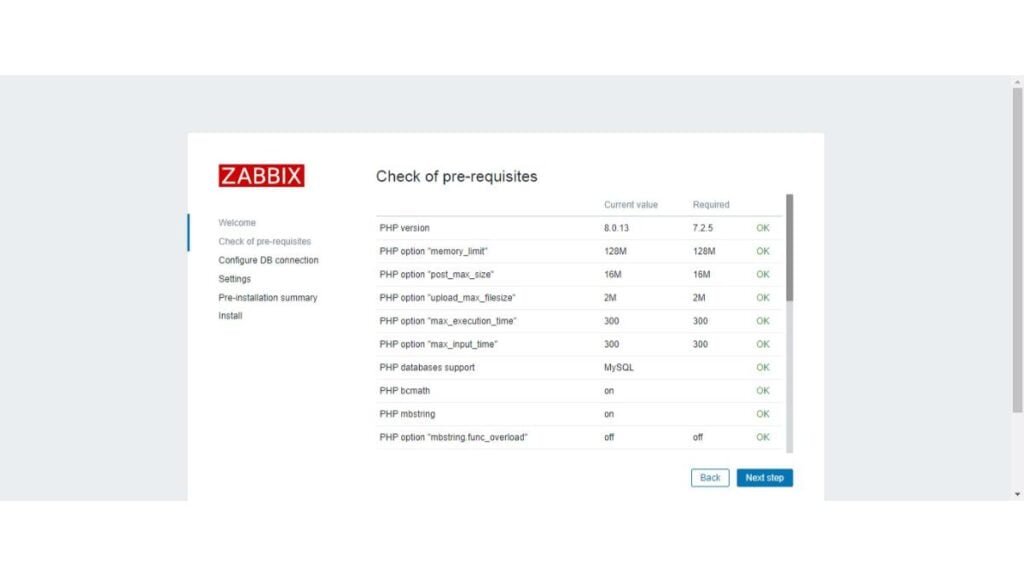
The installer will perform prerequisite check and display the status of the check.
If you exactly follow the above steps then all the prerequisites will be ‘OK’.
Click on “Next Step” button.
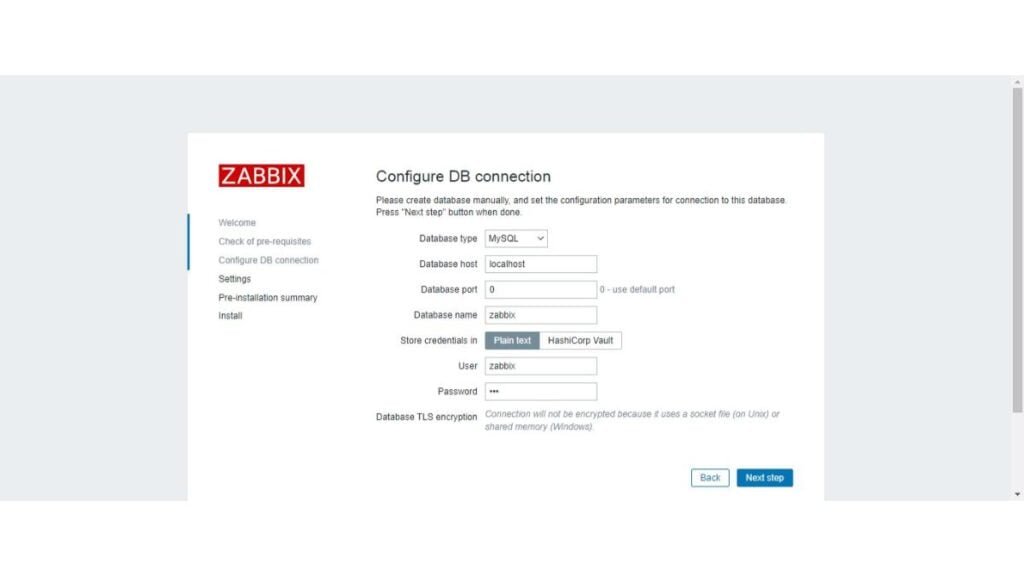
Configure your database connection and press “Next Step” button.
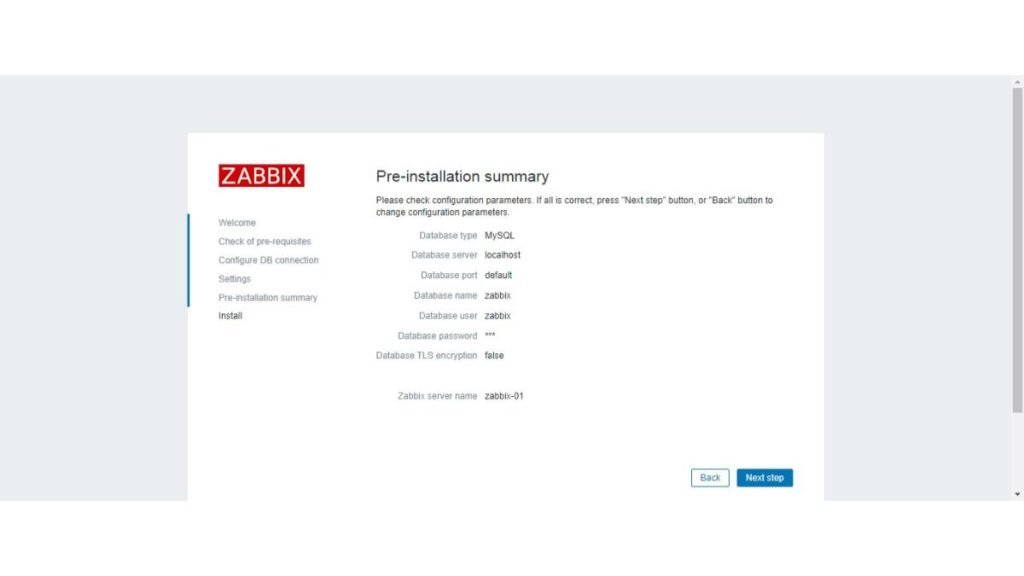
Have a look at the Pre installation summary and click on “Next Step”.
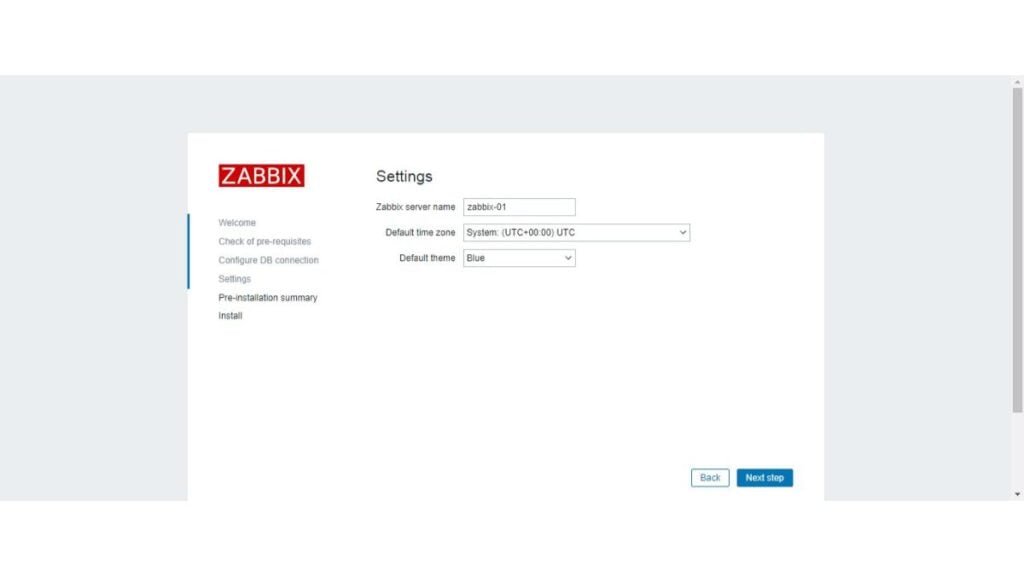
Provide a name for your Network monitoring server click on “Next Step”.
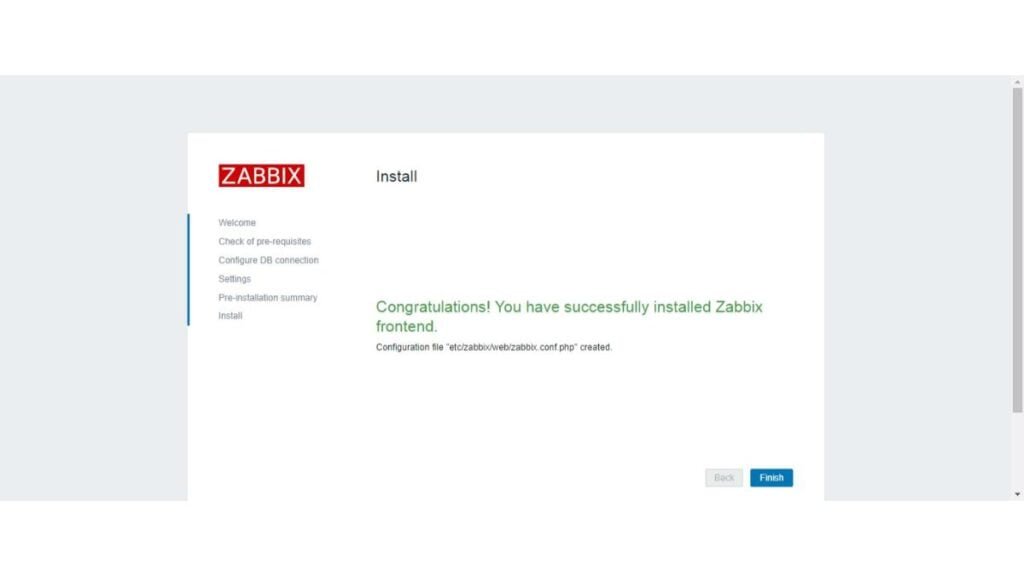
Zabbix front-end installation has been completed. Press “Finish” button.
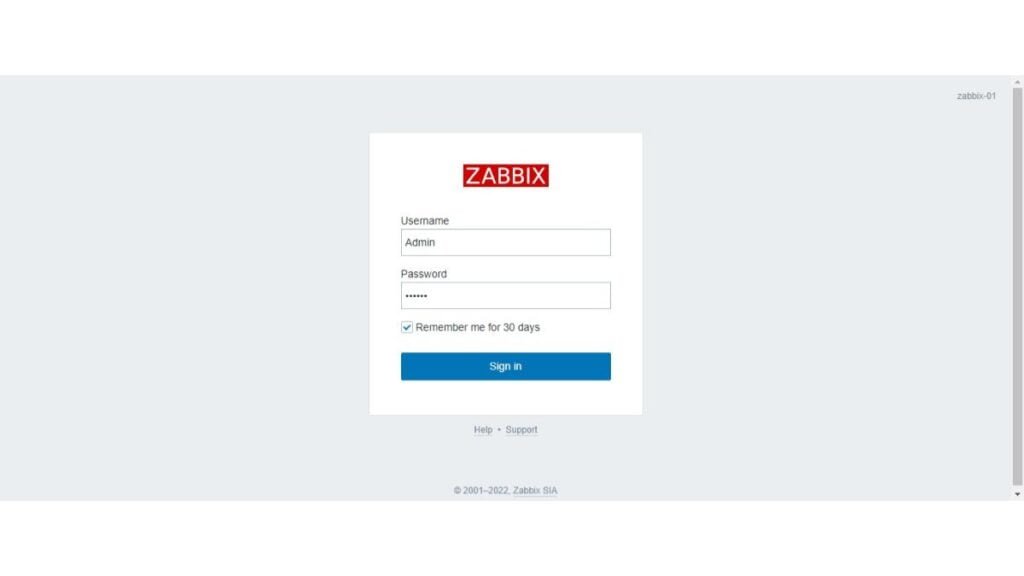
You have been redirected to Zabbix Web UI login. Login as default username/password i.e. Admin/zabbix.
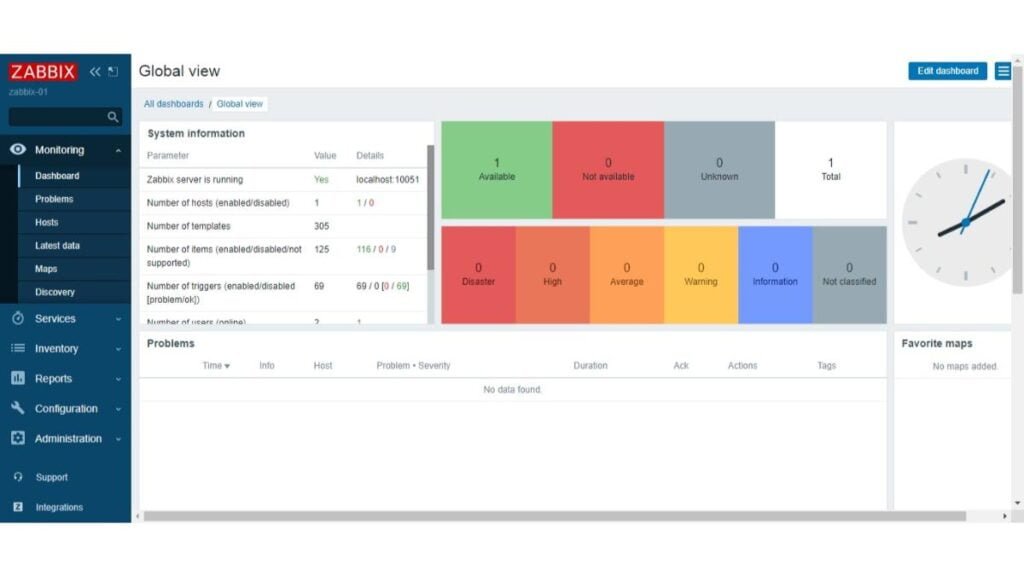
After successful login, you will see the main dashboard of Zabbix frontend.
Video Tutorial
Final Thoughts
Congratulations on successfully learning how to install Zabbix on Rocky Linux 9! With Zabbix up and running, you now have a robust monitoring solution to keep track of your network, servers, and applications. This setup will help you ensure optimal performance, quickly identify issues, and maintain a healthy IT infrastructure. Enjoy the benefits of proactive monitoring and efficient management. Happy monitoring!
From setting up scalable AWS solutions to managing complex Linux environments, I’ve got you covered. Visit my Freelancer profile to get started.
FAQs
1. Can Zabbix monitor both Linux and Windows machines?
Yes, Zabbix supports monitoring multiple platforms, including Linux, Windows, and network devices.
2. Is it necessary to install a web server before installing Zabbix?
Yes, Zabbix requires a web server like Apache or Nginx to host its frontend interface.
3. Can I use SQLite instead of MySQL or PostgreSQL for Zabbix?
SQLite is not recommended for production; MySQL or PostgreSQL are preferred for better performance and scalability.
4. How can I secure Zabbix from unauthorized access?
Use strong passwords, enable HTTPS, and restrict access via firewalls or IP whitelisting.
5. Does Zabbix support containerized installation on Rocky Linux 9?
Yes, Zabbix offers Docker images for containerized deployment, which can be an alternative to traditional installation.
What’s Next
If you’re serious about mastering IT infrastructure monitoring, I highly recommend the online course “Zabbix Application and Network Monitoring“ by Sean Bradley. This hands-on training is perfect for system administrators, DevOps engineers, and IT professionals who want to efficiently monitor applications, servers, and networks using Zabbix. With real-world examples and step-by-step guidance, you’ll gain practical skills that can immediately improve your monitoring workflows and career prospects.
Disclaimer: Some of the links in this post are affiliate links. This means if you click on them and make a purchase, I may earn a small commission at no extra cost to you. This helps support my work and allows me to keep creating helpful content.


Leave a Reply
Please log in to post a comment.